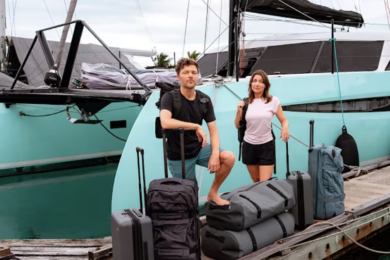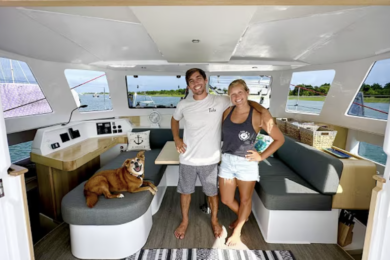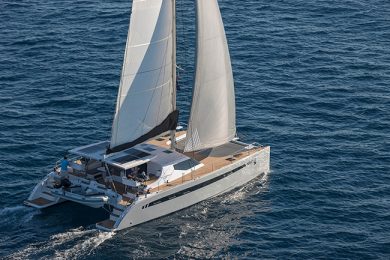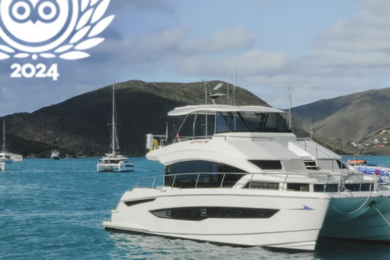
Carly and Pete Du Preeze sail to Cape Town from Brazil on their catamaran Oryx . (Published Summer 2015)
We cleared customs in Angra dos Reis, just south of Rio De Janeiro, Brazil, and stocked up on fresh fruit and vegetables for the passage. Stocking up for a passage was slightly complicated by us not having refrigeration, so we tried to find fruit and veggies that hadn’t previously been refrigerated. We washed everything in a mild chlorine solution and strung up the extra bell peppers. The yogurt was stored in our shallow bilge.
We then sailed to Abraão, on Ilha Grande to stock up with spring water and await a favorable forecast. We carry over 200 liters of water and usually catch additional rainwater in our dinghy Crake, while it is in the davits. On this passage, however, we had decided to lash it upside down up forward, to be safer in case of bad weather.
We then consulted three independent weather forecasts and set out after lunch on November 6, despite a front to the south, hoping to make use of the southerlies to sail eastwards. Initially, we had the wind astern and left the anchorage under sail—to the delight of friends.
Once clear of the anchorage, the breeze was blocked by the headland and we slowed down. Finally clear of the land, we sped up again only to be headed by the wind. Pete had spent the final morning scrubbing the bottom so we were going to windward well, despite having to dodge between the many anchored ships. By nightfall the wind had disappeared and we drifted along on a sea that looked like mirrored glass. Ilha Grande and her 365 purported islets provided the perfect cruising ground, but the wind tends to be terribly fluky and often light.
We did three hour watches at night and were more flexible during the day. The A.I.S. receiver simplified our watch keeping and I no longer needed to call Pete as frequently. I still did a thorough lookout every 10 to 15 minutes, but checked the shipping movements on the A.I.S. only raising the alarm if the closest point of approach was less than a mile. There were still fishing boats about, so we had to remain vigilant.
I turned in after my watch, but awoke several hours later to find that we were pounding to windward again, with Pete still on watch. We were doing a steady five knots, through thick mist. Pete was keeping a close lookout for ships with A.I.S. assistance.
By breakfast the sun broke through and the wind dropped to less than a knot! I still felt the pull of Brazil, but Ilha Grande was lost in the thick bank of fog. Ahead the sun was shining and the skies were clear. The haunting calls of the fog horns added a surreal touch and a ship loomed on the starboard quarter, shedding the mist like a shroud.
THE FIRST WEEK
The first week was characterized by mixed weather. The first day was sunny with the wind picking up by sunset until we were pounding to windward with breaking seas all around. The motion of a catamaran was an improvement on that of our previous monohull, but I still had to reach for an anti-emetic when the seas were short and choppy. We were reefed right down and again Pete did a double watch due to the proximity of oil rigs.
Oryx’s main berth is on the bridge deck with single berth in the port quarter, which we use in rough weather. Due to good clearance of the bridge deck we could usually sleep in our cabin, but if the pounding grew loud, we retreated to the sea berth, where the borborygmi of Oryx and the sea lulled us to sleep. On this occasion, I slept fitfully—the swirling seas sounding more like a tumultuous washing machine, although fortunately rather dryer.

Much of the first week the wind was squarely on the nose and all the weather forecasts were wildly inaccurate. Midweek we experienced some squalls, one with gusts up to gale force. My fear and discomfort factor was steadily rising. Pete is a seasoned sailor, but I am still a fledgling and a self confessed coward. The south Atlantic crossing in Oryx was bound to be tough. Oryx had led a charmed life, coasting through the Bay of Biscay and a north Atlantic crossing,but we had yet to experience a full blown gale in her.
My first Atlantic crossing had been from Mar del Plata in Argentina with Pete on Pelican his junk rigged Freedom 33 and three days into the passage we experienced a knock down. Fortunately, Pelican popped up like a cork, but I knew that catamarans don’t behave similarly, so when I awoke to the thunderous sounds of the sea, my heart was hammering, my throat was dry and I was regretting my more foolhardy and exciting choices in life.
By day, the horizon seemed to stretch endlessly to infinity and beyond. By night, the absolute darkness was peppered with thousands of stars strewn around and the sight charmed and calmed me. Oryx was zipping along, ever to windward, trailing phosphorescence and the beauty of sailing quelled all my doubts once more. Our only companions were a motley assortment of sea birds.
By the second week, the wind had shifted into the northeast and was blowing force seven with frequent squalls. Oryx was maintaining speeds of over seven knots with just the top of the windward sail up.
A bleak 48 hours of fine, drenching rain, interspersed with heavy downpours followed and the only relief was the company of three shear waters, riding the thermals. The barometer remained as steady as the rain, providing a modicum of reassurance. Back on board our bananas had ripened too quickly, but the other fruit and vegetables were doing well.

During one of the fiercer squalls, I woke with a start and lay riveted to the bunk. Oryx, the water and the wind were all wailing, but Pete was silent. For a moment I feared for Pete, but he was merely maintaining watch until the squall abated, I lay in the sea berth, listening to the cacophony of sounds. The night had deteriorated into a heavier deluge of rain accompanied by gale force winds. It was wet, wet, wet and my tears of fear didn’t help. The seas were huge and there were mountains of water all around. Oryx was coping far better than her crew.
Morning brought a short-lived lull, but it was pouring again by noon. The wind was abeam and the seas started building again, crashing loudly against the starboard beam. By 1500 we were unable to hold our course. We had only a fragment of one top panel of a sail up, but we were doing more than seven knots. Pete deployed our Jordan’s Series Drogue at 1600. The relief was almost instantaneous. Our speed dropped to one and a half knots. The noise was reduced a hundredfold and we were able to catch up on much needed sleep. It was like camping in a valley of waves, while the storm continued to rage overhead. The drogue kept us stern to the wind and seas and relative peace reigned.
We continued our watches, as our manoeuvrability was restricted by the drogue and hence were more vulnerable to being run down. Luckily we were far from shipping lanes. A rogue wave swept our port quarter and damaged the self-steering during the night, but Pete managed to set up an alternative system using rope and pulleys, once the storm had abated.
The morning brought sunshine and after breakfast we brought in the drogue, which took less than 20 minutes. As the wind continued to die down the seas abated rapidly. The wind was heading us again, but it was fairly light. Our progress was slow, but pleasant. We both enjoyed the respite from the storm.
Shortly afterwards we were becalmed. By this stage we had seen a few wandering albatross and we often had a bevy of other albatross gliding on the thermals. When becalmed they bobbed about alongside, merely flying to catch up on occasion. The calm dissolved into the lightest of breezes astern and Oryx trickled along. We now saw ships on rare occasions and a large container ship altered coarse to come close by to see if we were okay. They seemed bemused when we asked if they were all right, too.
JOURNEYING ON
Almost three weeks into the passage, we finally caught up with the illustrious westerlies and were sailing briskly downwind. The day was hazy, but Oryx’s performance and motion made the sailing pleasant. Once we had deployed the drogue and survived the first gale without incident, my confidence in Oryx and in myself grew and I was able to relax and enjoy the passage.
We were sitting sipping coffee in the cockpit, enjoying the fine weather and the company of a yellow nosed albatross who was following us, flying ahead, sheathing his wings and waiting for us to catch up and then repeat the game perpetually. It was so quiet that we could hear the albatross’ wings. Suddenly a tremendous ripping noise, tore the silence asunder! A whale breached astern.
Before sunset there was a strange metalic smell about. It smelt like Johannesburg before a thunderstorm. I remembered my mother calling it ‘ozone’. Without recourse to Wikipedia, I reached for the dictionary, only to confirm that ozone was a pungent form of oxygen.
With a watchful eye on the barometer, we rejoiced as the wind kicked in and with virtually flat seas, Oryx was soon flying along. The wind was astern and our twin wind vane self-steering was functioning perfectly. The average speed was now in the high seven’s with surges of eight, nine and 10. We reefed down accordingly. It was so comfortable that we were back to sleeping in our normal cabin.
The brilliant runs continued, but the barometer started dropping. We were due to reach Tristan Da Cunha after dark, so Pete dropped all sails to reduce speed, hoping to delay our arrival until daylight. Unfortunately, with no sail up, the windage made us do five knots. The seas were building and abeam, bashing Oryx badly, so we deployed the drogue again, just before the wind started shrieking like a banshee. Once again my thanks went out to Mr. Jordan, his ingenuity and public spiritedness.
The wind raged all night and by morning we were off Inaccessible Island. The front had come through shifting the wind into the south west and we were now heading for Tristan de Cunha, but unfortunately the wind blew just as strongly. The sun reappeared and a small rise in the barometer raised my hopes for landfall at Tristan, but the waves showed no sign of dying down. Soon the roadstead anchorage of Edinburgh was abeam, but we had to sail by, as the open roadstead anchorage there was untenable.
The last day of November dawned with Tristan now astern and the waves still about three meters. We brought the drogue in after it had been out for a record 41 hours. We sadly decided to give Tristan a miss because we would have to beat back and then wait for the waves to die down, as there is no real harbour and Christmas was calling.
The albatross flotilla kept growing and we spent much time admiring their elegant flight patterns. They never flap their wings, but glide and soar upon the thermals with minimal foot moments to change direction. With the wind in the north west Oryx cracked her previous record with a run of 167 miles and day after day we enjoyed great runs. On one occasion, in the early hours of the morning Oryx jibed unexpectedly, when we surged up to 12.3 knots. I flew into the cockpit, but fortunately there was no damage and we were maintaining our course, but I reefed down reluctantly. We have found that the self-steering only copes up to a certain point, nine or 10 knots, and unless we are prepared to hand steer, we cannot let Oryx sail too swiftly.
Just before completing a month at sea we cracked the 1,000 nautical miles to go target and a few hours later we crossed the Greenwich Meridian. We celebrated with a fine meal accompanied by a glass of wine and our final English steam pudding. Two years after our launch the can was just beginning to rust, but the pudding was as good as ever.
As December progressed we were becoming impatient as the wind got lighter. We drifted along and when the wind arrived it was from ahead but at that stage we were just thankful to be moving. Fortunately the lull and shift was short lived and I awoke to Oryx gurgling once more, with her sails wing and wing and she was soaring!
The seas were a deep, multifaceted sapphire, reflecting the golden glow and sporting white crested lace. Thus started a memorable day. I went to adjust the self-steering and noticed mud in the water. I checked the echo sounder in alarm, but we were still in fathomless depths. The discoloration was only evident for a few boat lengths. I pondered over the source of the discoloration and decided that it could be blood.
Shortly afterwards I glanced at the waves astern and spotted two sharks bearing down on our lure! I hadn’t seen their fins, instead it was a momentary full frontal view highlighted by the light astern. It was as if they were frozen in time and space. I hastily retrieved the lure.
I lingered in the cockpit trying to catch another glimpse. An assortment of birds surfed the thermals and I later spotted dolphins and the distant spray of a whale. I was really pleased, but none of the sightings warranted waking Pete, so I enjoyed the experience in silence as the miles spun away with the wake. These are the moments that make each passage a uniquely beautiful experience.
CAPE TOWN SPOTTED
After many miles without any, the ships started reappearing, sporadically at first and then with unerring regularity as we neared the Cape. On our final day the winds were variable once more. We spotted land at 1100. It was hazy, but we thought we could identify the landmark known as the Twelve Apostles.
We were initially heading for the anchorage and yacht club in Hout Bay, but a strong southeaster was filling in, making the bay unsuitable. We changed course for Granger Bay, a sheltered anchorage off the waterfront in Cape Town, just as the sun set.

Small dolphins came torpedoing through the waves, speeding past. With the wind astern and Pete at the helm we were doing over 12 knots and the dolphins continued to fly by! I went onto the foredeck to take photographs and then dropped the camera into the sea. The beautiful scenery suddenly palled as I bemoaned my carelessness. We arrived in Granger Bay after dark. The waves were crashing on the rocks and seemed close, but Pete was confident as always and we anchored safely without ado and gratefully turned in together, at last. It had taken us 34 days to sail the 3734 miles.


















